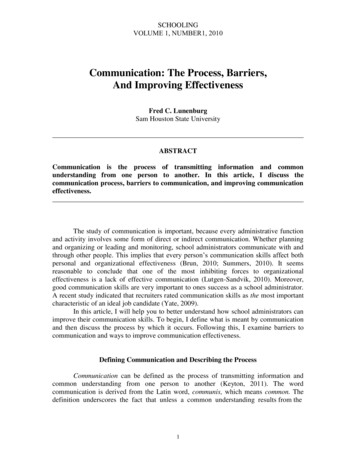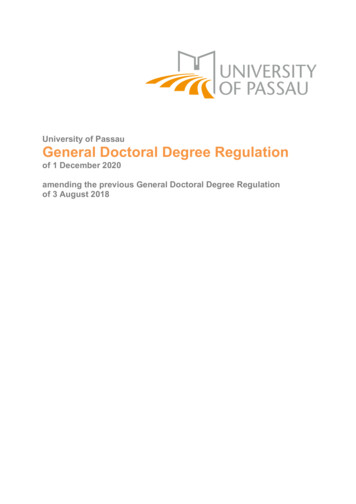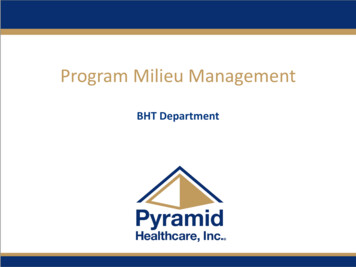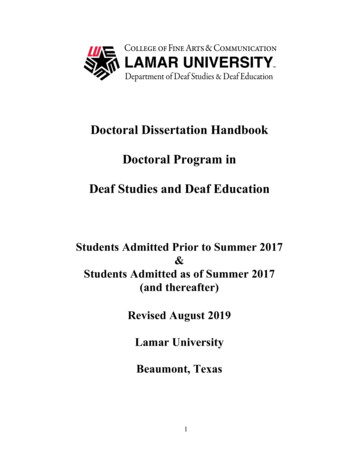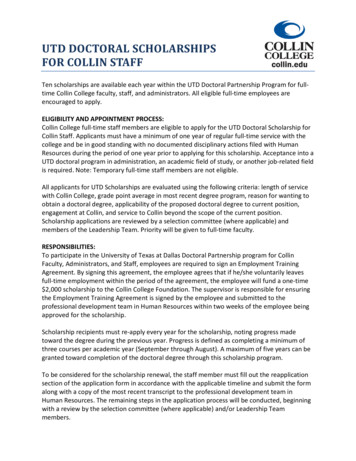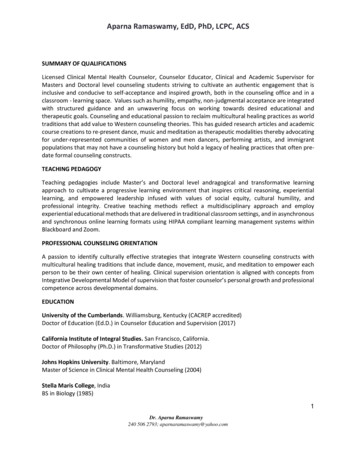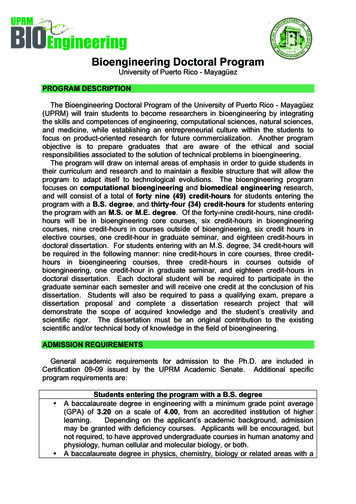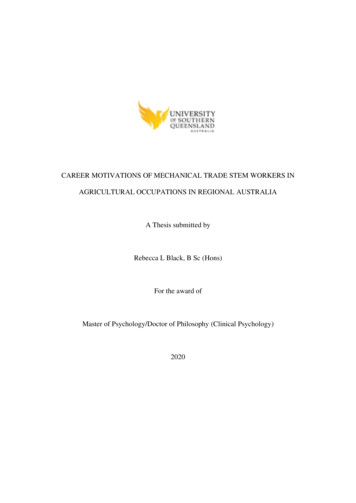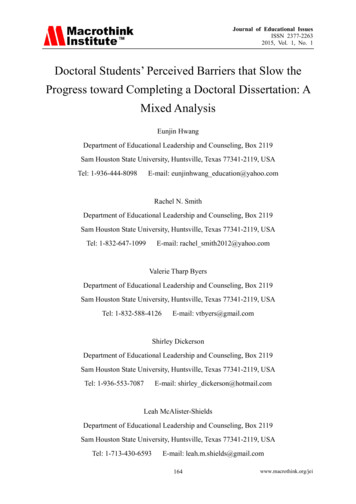
Transcription
Journal of Educational IssuesISSN 2377-22632015, Vol. 1, No. 1Doctoral Students’ Perceived Barriers that Slow theProgress toward Completing a Doctoral Dissertation: AMixed AnalysisEunjin HwangDepartment of Educational Leadership and Counseling, Box 2119Sam Houston State University, Huntsville, Texas 77341-2119, USATel: 1-936-444-8098E-mail: eunjinhwang education@yahoo.comRachel N. SmithDepartment of Educational Leadership and Counseling, Box 2119Sam Houston State University, Huntsville, Texas 77341-2119, USATel: 1-832-647-1099E-mail: rachel smith2012@yahoo.comValerie Tharp ByersDepartment of Educational Leadership and Counseling, Box 2119Sam Houston State University, Huntsville, Texas 77341-2119, USATel: 1-832-588-4126E-mail: vtbyers@gmail.comShirley DickersonDepartment of Educational Leadership and Counseling, Box 2119Sam Houston State University, Huntsville, Texas 77341-2119, USATel: 1-936-553-7087E-mail: shirley dickerson@hotmail.comLeah McAlister-ShieldsDepartment of Educational Leadership and Counseling, Box 2119Sam Houston State University, Huntsville, Texas 77341-2119, USATel: 1-713-430-6593E-mail: leah.m.shields@gmail.com164www.macrothink.org/jei
Journal of Educational IssuesISSN 2377-22632015, Vol. 1, No. 1Anthony J. Onwuegbuzie (Corresponding author)Department of Educational Leadership and Counseling, Box 2119Sam Houston State University, Huntsville, Texas 77341-2119, USATel: 1-936-294-4509E-mail: tonyonwuegbuzie@aol.comCindy BengeDepartment of Educational Leadership and Counseling, Box 2119Sam Houston State University, Huntsville, Texas 77341-2119, USATel: 1-281-985-6401Received: May 30, 2015doi:10.5296/jei.v1i1.7703E-mail: clbenge@aldineisd.orgAccepted: June 28, 2015Published: June 30, 2015URL: http://dx.doi.org/10.5296/jei.v1i1.7703AbstractThe non-completion of doctoral degrees has been a concern due to its economic, social, andpersonal consequences. In the current study, the researchers investigated perceived barriers ofselect doctoral students in completing their doctoral degrees by utilizing a fully mixedsequential mixed research design. The quantitative and qualitative data were concurrentlycollected using identical samples (n 205) via a Reading Interest Survey questionnaire. Asequential mixed analysis revealed 6 emergent themes: external obligations (36%),challenges to doctoral-level researchers (34%), practical/logistical constraints (23%),emotional concerns (15%), program structure (9%), and support for completion (8%). Also, 3meta-themes were identified (i.e., dissociation, external/internal barriers, andinstitutional/personal barriers), which aided in explaining the relationships among the 6primary themes. Implications of the findings are discussed.Keywords: Doctoral students, Doctoral degree completion, Barriers of doctoral students,Mixed methods research, Mixed research, Mixed analysis1. IntroductionDoctoral students are the most educationally advanced students in the higher educationsystem; yet, paradoxically, this group is the least likely to achieve their main academicgoal—doctoral degree completion (Golde, 2000). According to the Council of GraduateSchools (CGS, 2008), only 41% of students enrolled in doctoral programs in the UnitedStates successfully complete their degrees within a period of 7 years. Further, only 57%complete their degrees within a 10-year time-frame. Moreover, 20% of doctoral candidatesdropped out at the coursework completion stage, with only the dissertation remaining (Bowen165www.macrothink.org/jei
Journal of Educational IssuesISSN 2377-22632015, Vol. 1, No. 1& Rudenstine, 1992).The loss of doctoral students midway in the academic process has been a concern because thereduced retention of the highly educated individuals results in economic and intellectualdrains in both universities and funding agencies (Bowen & Rudenstine, 1992; McAlpine &Norton, 2006). In addition to this economic and intellectual drain, doctoral student attritionhas social and personal consequences (e.g., depleting intellectual competitiveness anddevastating personal lives; Gardner, 2009). The loss of doctoral students who finish all buttheir dissertations is detrimental for the departments and universities because the totalexpense per student accumulates while each student is enrolled in coursework. In order tolower attrition rates and to facilitate completion rates of doctoral students, knowledge ofconstraining factors influencing doctoral students’ degree completion is needed.Unfortunately, this information currently is lacking.Given the paucity of information in the literature, the purpose of this study was to investigatepossible barriers that doctoral students experience, especially when working towardscompleting their dissertations. We hoped that this investigation would be informative forfaculty members or administrators in higher education in helping to promote doctoralprograms by suggesting effective support mechanisms.1.1 Gender, Grade Point Average, and Doctoral Degree CompletionA number of researchers have identified gender differences in quantitative outcomes—suchas grade point average (GPA) in colleges—indicating that female undergraduate students tendto have higher GPAs than do their male counterparts (e.g., Chee, Pino, & Smith, 2005).Similarly, findings from some previous studies have indicated that at the graduate level,female students have tended to outperform male students with equal or better GPA scores(Berg & Ferber, 1983; Girves & Wemmerus, 1988). However, research on the relationshipbetween gender and GPA among doctoral students currently is lacking.With respect to the relationship between academic factors and doctoral degree completion,Bair and Haworth (2005), who conducted a qualitative meta-synthesis of published researchstudies, concluded that academic achievement indicators such as GPA did not predict degreecompletion effectively. Consistent with Bair and Haworth (2005), Malone, Nelson, andNelson (2004) reported that GPA had a minimal impact on doctoral completion,recommending that researchers focus on non-quantitative factors that determine the quality ofdoctoral programs in seeking knowledge on doctoral completion.Likewise, gender has not been found to be a determinant of doctoral degree completion(Attiyeh, 1999; Malone et al., 2004). However, gender differences in the employment andcareer path during or after doctoral program have been identified (Malone et al., 2004).Malone et al. (2004) documented gender differences in the field of educational administrationin terms of employment and career, indicating that male and female doctoral students bringdifferent needs, aspirations, and expectations at the entry of their programs. Even thoughgender has not emerged as a statistically significant predictor of doctoral degree completion,many researchers have documented the unique challenges and barriers of female doctoral166www.macrothink.org/jei
Journal of Educational IssuesISSN 2377-22632015, Vol. 1, No. 1students in completing their doctoral programs (e.g., Maher, Ford, & Thompson, 2004;Manfield, Welton, Lee, & Young, 2010; Moyer, Salovey, & Casey-Cannon, 1999). Thesechallenges have included greater work demand, financial constraints, child-careresponsibilities, and low level of confidence (Maher et al., 2004; Manfield et al., 2010;Moyer et al., 1999).1.2 Constraining Factors to Doctoral Student CompletionPrevious studies have shown that various factors influence degree completion (Lovitts, 2001).In particular, Smith, Maroney, Nelson, A. L. Abel, and H. S. Abel (2006) documented thatboth institutional and individual factors contribute to high rates of attrition. Institutionalfactors that have existed within the doctoral program include doctoral program structure,doctoral student adviser, and the lack of program flexibility. In contrast, individual factorsinclude relationships and responsibilities within family and work life, other strains of finance,time, and overload and established support systems buffering all the challenges (Smith et al.,2006). Additionally, Golde (2005) identified inadequate academic integration as a significantfactor influencing the attrition of doctoral students in association with Tinto’s (1993) theory.Many researchers have attempted to investigate constraining factors to doctoral studentdeparture; however, most of these studies have been solely quantitative or qualitativedominant in nature, and only a few researchers (e.g., Wao & Onwuegbuzie, 2011) haveutilized mixed research (i.e., mixed methods research) techniques. Thus, in the current study,we examined perceived barriers in completing doctoral programs by utilizing mixed analysesof both quantitative and qualitative data.2. Theoretical FrameworkTwo theories were utilized as a theoretical framework for the study. First, Tinto’s (1993)doctoral persistence theory was employed to explain the reasons that might impede doctoralstudents’ degree completion. Tinto’s (1993) doctoral persistence theory is derived fromTinto’s (1975) Interactionist Model emphasizing the interaction within the academicenvironment to explain dropouts of undergraduate students. However, Tinto (1993) clarifiedthe differences between undergraduate/master’s students and doctoral students, which involveintensity of social and academic integration as well as a sense of belonging not only todepartments/institutions but also to fields of study. To understand doctoral student persistence,Tinto (1993) conceptualized a theoretical model with three stages, transitional phase, leadingto candidacy, and dissertation. Tinto (1993) postulated that doctoral students might havevarious challenges in each phase, but they can achieve their professional career attainments ifthey are persistent throughout the phases. Additionally, in attaining their professional careers,relationships with professors and peers are imperative, directly facilitating the academic andsocial integration of doctoral students (Tinto, 1993).Second, Weidman, Twale, and Stein (2001)conceptualized a graduate socializationframework that highlighted relationships with individuals who provide support to doctoralstudents for their completions. Even though the relationship with faculty or advisors is centralwith respect to doctoral completion, personal communities (e.g., family, friends, andemployers), who are not associated with academic programs but influence the graduate167www.macrothink.org/jei
Journal of Educational IssuesISSN 2377-22632015, Vol. 1, No. 1completion, also are included within the framework (Weidman et al., 2001). The graduatesocialization process involves four stages (i.e., anticipatory, formal, informal, personal stage)that students undergo, and this process is nonlinear, dynamic, and ongoing (Weidman et al.,2001).Taken together, both theoretical models for doctoral student persistence provide a frameworkfor understanding various factors that might influence persistence and attrition of doctoralstudents. Figure 1 displays how these two theories combined provided a framework for thisstudy. Tinto’s (1993) doctoral theory of persistence explains the interaction between studentsand institutions throughout the stages of doctoral programs (i.e., coursework, candidacy,dissertation), whereas Weidman et al.’s (2001) graduate socialization framework illuminatesa dynamic and fluid socialization process of doctoral students entangled with variouscomponents, including relationships within both professional communities and personalcommunities. Based on these theories, we explored possible challenges at the stage of degreecompletion within the academic program as well as other challenges outside of the academicprogram that might slow doctoral degree completion.Interaction with Faculty and PeersFormal/Informal InteractionWithin the academic environmentInteraction with Personal CommunitiesTintoWeidman et al.Socialization/IntegrationProspective StudentInitial Goal CommitmentStudent CharacteristicsDispositionNovice Professional PractitionerCommitmentPersonal/Professional IdentityFigure 1. Theoretical framework for the current study3. Methodological FrameworkCollins, Onwuegbuzie, and Sutton’s (2006) 13-step model was utilized as a methodologicalframework for the current mixed research study. These 13 steps, which are continuous andinteractive, occur at three stages of the mixed research process (i.e., the Formulation Stage, thePlanning Stage, and the Implementation Stage). Each step is highlighted in the followingsections.168www.macrothink.org/jei
Journal of Educational IssuesISSN 2377-22632015, Vol. 1, No. 13.1 Mixed Goal (Step 1)Newman, Ridenour, Newman, and DeMarco’s (2003) typology identified potential goals of amixed research study. Their nine goals of research are (a) to predict; (b) to add to theknowledge base; (c) to have a personal, social, institutional, and/or organizational impact; (d)to understand complex phenomena; (e) to measure change; (f) to generate new ideas; (g) totest new ideas; (h) to inform constituencies; and (i) to examine the past. The goals of thiscurrent study were (a) to add to the knowledge base and (b) to have a personal, social,institutional, and/or organizational impact.3.2 Mixed Research Objectives (Step 2)According to Johnson and Christensen (2010), there are five major research objectives. Theseobjectives are (a) exploration, (b) description, (c) explanation, (d) prediction, and (e)influence. For this study, the objective in the qualitative phase was to explore the perceivedbarriers of doctoral students’ degree completion; the objective of the quantitative phase wasto describe this phenomenon; with regard to the mixed research phase, the objective was toexplain the relationships among the perceived barriers of doctoral students’ degreecompletion.3.3 Rationale for Mixing (Step 3)Four rationales for conducting mixed research have been identified by Collins et al. (2006).These rationales are (a) participant enrichment, (b) instrument fidelity, (c) treatment integrity,and (d) significance enhancement. Our rationale for mixing quantitative and qualitativetechniques was significance enhancement. Significance enhancement concerns utilizingqualitative and quantitative research techniques to enhance the interpretation of data. Withrespect to significance enhancement, both qualitative and quantitative data were collected viathe questionnaire that contained open- and closed-ended items to maximize the interpretationof data (i.e., quantitative analyses were utilized to enhance qualitative analyses). For example,themes were generated from the qualitative responses, and, additionally, the relationshipbetween these themes and quantitative variables (i.e., gender, GPA) were investigated. Bymixing qualitative and quantitative data analyses, both sets of data expanded and confirmedwhat was learned from the other set, which enhanced the significance of the findings.3.4 Purpose for Mixing (Step 4)Using Greene, Caracelli, and Graham’s (1989) typology, two purposes for mixing qualitativeand quantitative research approaches were employed. These were (a) complementarity (i.e.,utilizing both qualitative and quantitative techniques to measure a phenomenon from multipleaspects leading to richer data) and (b) expansion (i.e., increasing the scope of the study byutilizing different methods to evaluate the different components of the inquiry). Thepurposes of this study were (a) to explore the perceived barriers of doctoral students incompleting their doctoral programs, (b) to examine the relationships among the perceivedbarriers, and (c) to examine the relationships between barriers and quantitative variables(gender, GPA).169www.macrothink.org/jei
Journal of Educational IssuesISSN 2377-22632015, Vol. 1, No. 13.5 Research Questions (Step 5)For the current study, combination research questions were used. According to Plano Clarkand Badiee (2010), combination research questions represent at least one mixed researchquestion combined with separate quantitative and qualitative research questions. In our study,the research questions were as follows:Quantitative research question. For the quantitative phase of this study, the followingresearch question was addressed:(a) What is the relationship between gender and GPA of selected doctoral students?Qualitative research question. For the qualitative phase of this study, the following researchquestion was addressed:(b) What are the perceived barriers that slow the progress toward completing a doctoraldissertation?Mixed research questions. The following mixed research questions were addressed:(c)What is the prevalence of each of the perceived barriers that slow the progress towardcompleting a doctoral dissertation?(d) How do these perceived barriers that slow the progress of doctoral students in completingtheir dissertation relate to one another?(e) What is the relationship between themes and quantitative variables (i.e., gender, GPA)?4. Method4.1 Participants and SettingThe participants (n 205) were students enrolled in doctoral programs across 32 differentmajors within the College of Education at a large Tier I research university in thesoutheastern United States. These participants were enrolled in either a Ph.D. program (n 174, 84.9%) or an Ed.D. (n 31, 15.1%) program. The majority of participants was female (n 123, 60.0%), English speaking (n 178, 86.8%), and White (n 130, 64.3%). Theremaining participants were American Indian or Alaskan Native (n 30, 14.9%), Hispanic orLatino (n 18, 8.9%), Black or African American (n 14, 6.9%), or Asian (n 10, 5.0%).Approximately 53.2% (n 109) of the doctoral students were working on a full-time basis.The mean GPA was 3.97 (SD 2.60) on a 4-point scale.4.2 Sampling Design (Step 6)The 205 doctoral students were selected via a convenience sampling scheme (Johnson &Christensen, 2010). Because a minimum sample size of 128 provided a statistical power of .80for detecting a statistically significant and moderate (i.e., Cohen’s [1988] d .50) differencebetween two groups at the 5% level of statistical significance (Faul, Erdfelder, Lang, &Buchner, 2007), the sample size of 205 represented more than adequate statistical power fordetecting this difference. A concurrent design using identical samples (Collins, Onwuegbuzie,170www.macrothink.org/jei
Journal of Educational IssuesISSN 2377-22632015, Vol. 1, No. 1& Jiao, 2007; Onwuegbuzie & Collins, 2007; Onwuegbuzie, Slate, Leech, & Collins, 2007)was utilized as the mixing sampling design. Specifically, all 205 contributed data to both thequalitative and quantitative phases of the investigation that were collected concurrently.4.3 Research Design (Step 7)Using Leech and Onwuegbuzie’s (2009) typology of mixed research designs, this study wasdetermined to represent a fully mixed concurrent equal status design because (a) thequalitative and quantitative approaches were mixed within multiple stages of the researchprocess, specifically, the data collection, data analysis, and data interpretation stages; (b) theinitial quantitative and qualitative data were collected and analyzed concurrently, and (c) bothphases were given nearly equal weight.4.4 Data Collection (Step 8)Instrument. The key instrument utilized for this study was a Reading Interest Survey (RIS).This instrument elicited background information (e.g., gender, age, native language, ethnicity,present major field of study, and degree pursuing). In addition, the RIS contained open-endeditems (e.g., What factors do you believe slow your progress toward completing yourdissertation?).Procedure. At the time of data collection, informed consent forms and a RIS questionnairewere distributed to all participants, followed by the approval of the Institutional Review Board(IRB). Informed consent forms were collected with the completed questionnaires. Allprecautions were taken by the researchers in the study not to reveal the identities of therespondents. Any identifying information was removed from the dataset.4.5 Data Analysis (Step 9)Mixed analysis. A sequential mixed analysis (SMA; Onwuegbuzie & Teddlie, 2003;Tashakkori & Teddlie, 1998) was used to analyze the data. The SMA comprised six stagesthat involved descriptive, exploratory, or confirmatory analyses. Specifically, the data wereanalyzed via a quantitative analysis (i.e., independent samples t test), followed by aqualitative analysis (i.e., a constant comparison analysis), followed by a quantitative analysisof the qualitative data. Each stage of data analysis will be described in the following sections.Stage 1: Descriptive analysis. In the first stage, an inferential analysis was conducted tocompare GPA scores across gender. Specifically, an independent samples t test was used toexamine the difference in GPA between the female and male doctoral students.Stage 2: Exploratory analysis. In the second stage, an exploratory analysis was undertaken toexamine the doctoral students’ perceptions of barriers that slow the progress towardcompleting a doctoral dissertation. The researchers conducted a constant comparison analysisto generate a set of themes from the data (Glaser, 1965; Glaser & Strauss, 1967). Accordingto Glaser (1965), the purpose of constant comparison analysis is to generate a theory by usinga more delineated and thorough process. Multiple rounds of reading narratives spurred thegeneration of descriptive codes and, subsequently, themes that indicated that saturation wasreached (Flick, 1998; Lincoln & Guba, 1985; Morse, 1995; Strauss & Corbin, 1990).171www.macrothink.org/jei
Journal of Educational IssuesISSN 2377-22632015, Vol. 1, No. 1The researchers progressed through the three stages of constant comparison analysis: (a) opencoding, (b) axial coding, and (c) selective coding (Glaser, 1965; Glaser & Strauss, 1967).Each researcher created and assigned multiple different codes to the data. These codingchoices were determined by each researcher’s interpretation of the data (Carley, 1993). Aftereach researcher independently generated codes through numerous rounds of coding, theresearchers paired into two groups and developed themes based on generated codes. Then, allresearchers discussed the themes that were developed between the two groups. For thepurpose of inter-coder agreement between these two groups, inter-coder reliability wascalculated using ReCal (Freelon, 2010). Krippendorf’s Alpha was .83, indicating goodagreement, 83% inter-coder reliability (Altman, 1991). A peer debriefing also was conductedin order to legitimize the data interpretations (Onwuegbuzie, Leech, & Collins, 2008). Forthis study, the remaining researcher who did not originally code the data served as the peerdebriefer. In order to examine the audit trail (Lincoln & Guba, 1985), the peer debriefer hadtwo goals: (a) to ensure that all interpretations stemmed directly from the data and (b) toensure that all researchers reached agreement on the themes that were identified.Stage 3: Exploratory analysis. In the third stage, each theme that was identified from theconstant comparison analysis was quantitized (Tashakkori & Teddlie, 1998). This techniqueallowed the researchers to determine the hierarchical structure of the emergent themes(Onwuegbuzie & Teddlie, 2003). Specifically, in order to determine the prevalence rate ofeach barrier theme, frequencies were computed by assigning either a score of “1” (if adoctoral student’s response contained a characteristic that was assigned to the particulartheme) or a score of “0” (otherwise). This dichotomization led to the development of aninter-respondent matrix of themes (i.e., student x theme matrix) (Onwuegbuzie, 2003a;Onwuegbuzie & Teddlie, 2003), which consisted only of 0s and 1s. By calculating thefrequency of each theme from the inter-respondent matrix, percentages were computed todetermine the prevalence rate of each theme (Research Question 3). These frequencies servedas effect sizes (Onwuegbuzie & Teddlie, 2003).Stage 4: Exploratory analysis. In the fourth stage, an additional exploratory analysis wasconducted by using the inter-respondent matrix of themes that was produced during theprevious stage to conduct a principal component analysis (Onwuegbuzie, 2003a). Specifically,an orthogonal (i.e., varimax) rotation was utilized. Three techniques were used to determinethe number of factors to retain (Kieffer, 1999): (a) the eigenvalue-greater-than-one rule (i.e.,K1) (Kaiser, 1958), (b) the scree test that represents a plot of the eigenvalues against thefactors in descending order (Cattell, 1966; Zwick & Velicer, 1982, 1986), and (c) a parallelanalysis (Thompson, 2004; Zwick & Velicer, 1982, 1986). These extracted factorsrepresented meta-themes (Onwuegbuzie, 2003a) such that each meta-theme contained one ormore of the emergent reason themes. As recommended by Onwuegbuzie (2003a), the trace,or proportion of variance explained by each factor after rotation, served as an effect sizeindex for each meta-theme. By determining the hierarchical relationship among the barrierthemes (Research Question 5), the verification component of categorization was empirical,technical, and rational (Constas, 1992). The meta-themes extracted via the principalcomponents analysis themselves were quantitized to dichotomous data (i.e., “0” vs. “1”),172www.macrothink.org/jei
Journal of Educational IssuesISSN 2377-22632015, Vol. 1, No. 1yielding an inter-respondent matrix of meta-themes.Stage 5 and Stage 6: Confirmative analysis. In the fifth stage, a chi-square automaticinteraction detection (CHAID; Kass, 1980) analysis was used to examine the relationshipsbetween the two demographic variables (i.e., gender, GPA) and the six barrier themes (Dillon& Kumar, 1994). In the sixth stage, a latent class analysis was conducted to determine thesmallest number of clusters (i.e., latent classes) that explains all the relationships among theemergent barrier themes. The latent class analysis was conducted under the assumption thatparticipants could be classified into a small number of distinct clusters known as latentclasses depending on their profiles of the barrier themes, such that each participant belongedto only one cluster.5. Results (Step 9)5.1 Stage 1: Descriptive FindingsBecause GPA scores for males and for females were not normally distributed, usingOnwuegbuzie and Daniel’s (2002) criteria of 3 for standardized skewness (i.e., skewnesscoefficient divided by its standard error) and standardized kurtosis (i.e., kurtosis coefficientdivided by its standard error) coefficients (see Table 1), a nonparametric (i.e., Mann-Whitney’sU) independent samples t test was used to assess gender differences in GPA scores. The resultrevealed a statistically significant gender difference in GPA, U 3579.50, p .05. TheCohen’s d effect size associated with this difference was 0.35. Using Cohen’s (1988) criteria,this finding represented a small effect size. Present in Table 2 are the descriptive statistics forGPA scores for male doctoral students and for female doctoral students.Table 1. Stage 1: Standardized skewness coefficients and standardized kurtosis coefficientsfor GPA scores by gender1GenderStandardized Skewness CoefficientStandardized Kurtosis CoefficientMales4.434.48Females-30.38133.87Note. 1: According to Onwuegbuzie and Daniel (2002), variables for which either thestandardized skewness coefficient (i.e., skewness coefficient divided by its standard error) orthe standardized kurtosis coefficient (i.e., kurtosis coefficient divided by its standard error),or both, are outside the 3 range suggest extreme departure from normality. Thus, bothvariables indicated very serious departures from normality.173www.macrothink.org/jei
Journal of Educational IssuesISSN 2377-22632015, Vol. 1, No. 1Table 2. Stage 1: Means and standard deviations of GPA obtained by males and .425.2 Stage 2 and Stage 3: Exploratory Theme-Related FindingsThe researchers identified codes and themes (Stage 2) by utilizing constant comparisonanalysis (Glaser, 1965; Glaser & Strauss, 1967). The following six themes emerged: externalobligations, practical/logistical constraints, emotional concerns, challenges to doctoral-levelresearchers, program structure, and lack of support for completion. Table 3 presents these sixthemes, along with corresponding significant statements, formulated meaning, and prevalencerate (Stage 3) of each theme (Onwuegbuzie, 2003a; Onwuegbuzie & Teddlie, 2003). Thetheme, external obligations was the most prevalent theme (36%), followed by challenges todoctoral-level researchers (34%), practical/logistical constraints (23%), emotional concerns(15%), and program structure (9%). The lack of support for completion theme was the leastprevalent theme, with a prevalence rate of 8%. Using Cohen’s (1988, pp. 180-183) non-lineararcsine transformation and Cohen’s (1988) d criteria led to cut-points of 1% endorsement asrepresenting a small effect size, 7% endorsement as representing a medium effect size, and 16%endorsement as representing a large effect size. Thus, four themes (i.e., external obligations,challenges to doctoral-level researchers, practical/logistical constraints, emotional concerns)represented a large effect size, whereas the remaining two themes (i.e., program structure,lack of support for completion) represented a moderate effect size.174www.macrothink.org/jei
Journal of Educational IssuesISSN 2377-22632015, Vol. 1, No. 1Table 3. Stage 2 and Stage 3 analyses: Themes, frequencies, formulated meanings, andselected examples of statementsThemesFrequencyFormulated MeaningSample Participant StatementsExternalobligations36%Family, job, social,medical obligationMy parents are ill, and my children are young. Bothrequire much of my time! Working full time may slowdown my progress.Challenges todoctoral-levelresearchers34%Concerns and unforeseenissues in the researchprocessWriting
Doctoral students are the most educationally advanced students in the higher education system; yet, paradoxically, this group is the least likely to achieve their main academic goal—doctoral degree completion (Golde, 2000). According to the Council of Graduate Schools (CGS, 2008), only 41% of students enrolled in doctoral programs in the United
